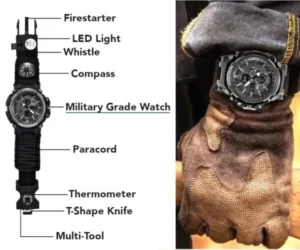G-Shock watches are renowned for their durability and water resistance, making them a popular choice for individuals who lead active lifestyles. Whether you’re an avid swimmer or simply prefer to keep your watch on while showering, you may have some questions regarding the water resistance capabilities of your G-Shock timepiece.
In this blog post, we will address nine common questions about swimming and showering with a G-Shock watch. From understanding water resistance ratings to knowing how to properly care for your watch, we aim to provide you with the information you need to confidently wear your G-Shock in water-related activities. So, if you’re curious about whether your G-Shock can handle the water, read on to find the answers you seek and ensure your watch stays protected in aquatic environments.

G-Shock 9 Durability and Water Resistance
G-Shock watches are renowned for their exceptional durability and impressive water resistance. Here are some key details about their durability and water resistance:
- Shock Resistance: G-Shock watches are specifically engineered to withstand shocks and impacts. They feature a rugged construction that includes a protective outer casing, reinforced buttons, and a shock-absorbent structure. This design allows them to withstand drops, vibrations, and other forms of physical impact.
- Water Resistance Ratings: G-Shock watches come with varying levels of water resistance, which are indicated by water resistance ratings in meters or atmospheres (ATM). Common water resistance ratings for G-Shock watches include 200 meters (20 ATM), 100 meters (10 ATM), and 50 meters (5 ATM). These ratings signify the depth to which the watch can be safely submerged without water entering the case.
- Screw-Down Crowns: Many G-Shock models feature screw-down crowns, which provide an additional layer of protection against water penetration. The screw-down crown is tightly sealed when screwed in, ensuring water resistance and preventing moisture from entering the watch’s internals.
- Resin and Stainless Steel Construction: G-Shock watches typically feature a combination of resin and stainless steel in their construction. The resin casing provides impact resistance and flexibility, while the stainless steel back case offers enhanced durability and corrosion resistance.
- Sealing and Gaskets: G-Shock watches employ specialized sealing techniques and rubber gaskets to create a watertight seal. These gaskets are strategically placed at critical points, such as the case back, crown, and buttons, to prevent water from entering the watch.
- ISO 6425 Certification: Some G-Shock models are certified to meet the ISO 6425 standard for diver’s watches. This certification ensures that the watch undergoes rigorous testing to demonstrate its water resistance, reliability, and performance under water.
- Additional Features: In addition to water resistance, G-Shock watches often come with other useful features for water-related activities. These can include a depth meter, countdown timer, stopwatch, and tide graph, allowing users to track their underwater adventures accurately.
How to Maintain Water Resistance
It is important to note that water resistance ratings are not a guarantee of absolute waterproofness. Water resistance ratings are based on laboratory tests in which the watch is subjected to a specific level of pressure and temperature.
In real-world conditions, the water resistance of a watch may be affected by factors such as the age of the watch, the condition of the seals and gaskets, and the environment in which the watch is used.
To maintain the water resistance of your G-Shock watch, there are a few key practices to follow. Regularly check the seals around the case back, crown, and buttons, ensuring they are clean, undamaged, and properly aligned. If you notice any signs of wear or deterioration, have them replaced by a certified watch technician.
Avoid subjecting your watch to extreme temperatures and handle it with care to prevent unnecessary impacts. After exposure to saltwater or chlorinated pools, rinse your watch with fresh water to remove any corrosive substances. Avoid pressing buttons underwater to reduce the risk of water entering the case.
It is also recommended to schedule regular maintenance checks with an authorized service center or watch technician who can perform thorough inspections and water resistance testing. By following these guidelines, you can help maintain the water resistance of your G-Shock watch and enjoy its reliable performance in water-related activities for years to come.
Conclusion
In conclusion, G-Shock watches are designed to withstand the rigors of swimming and showering, offering exceptional water resistance and durability. By understanding the water resistance ratings, properly maintaining your watch’s seals, and following recommended care guidelines, you can confidently enjoy your G-Shock timepiece in aquatic environments.
Remember to perform regular checks, such as inspecting the seals and ensuring proper operation, to ensure the continued water resistance of your watch. However, it’s essential to note that while G-Shock watches are built to be highly water-resistant, they are not invulnerable to damage. Extreme water pressures, exposure to hot water, or significant impacts can still pose risks.
As with any valuable possession, treat your G-Shock watch with care and respect its limitations to enjoy its longevity and reliable performance. So, dive into your adventures without hesitation, knowing that your G-Shock is ready to handle the water with confidence and style.

